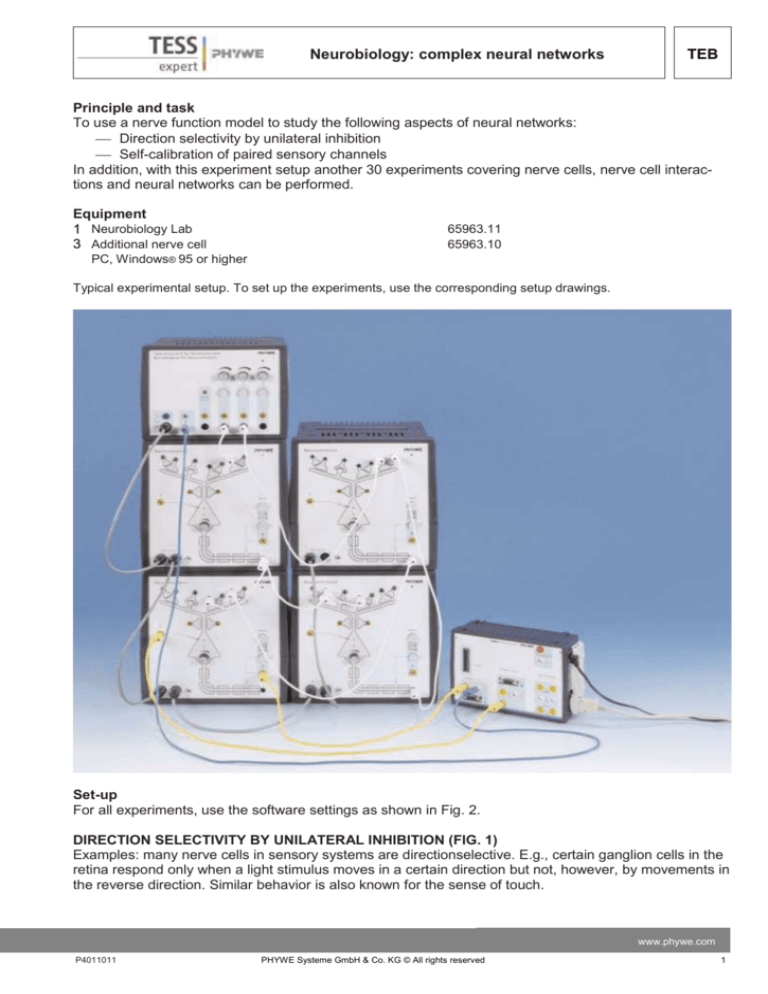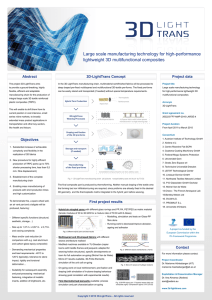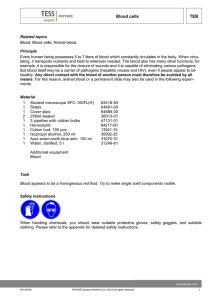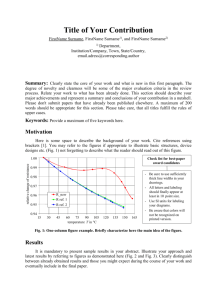
Neurobiology: complex neural networks
TEB
Principle and task
To use a nerve function model to study the following aspects of neural networks:
Direction selectivity by unilateral inhibition
Self-calibration of paired sensory channels
In addition, with this experiment setup another 30 experiments covering nerve cells, nerve cell interactions and neural networks can be performed.
Equipment
1 Neurobiology Lab
3 Additional nerve cell
65963.11
65963.10
PC, Windows® 95 or higher
Typical experimental setup. To set up the experiments, use the corresponding setup drawings.
Set-up
For all experiments, use the software settings as shown in Fig. 2.
DIRECTION SELECTIVITY BY UNILATERAL INHIBITION (FIG. 1)
Examples: many nerve cells in sensory systems are directionselective. E.g., certain ganglion cells in the
retina respond only when a light stimulus moves in a certain direction but not, however, by movements in
the reverse direction. Similar behavior is also known for the sense of touch.
www.phywe.com
P4011011
PHYWE Systeme GmbH & Co. KG © All rights reserved
1
TEB
Neurobiology: complex neural networks
This neuronal circuit can be simulated using a circuit with unilateral inhibition between two stimulus
channels which are activated successively.
Experimental setup (see Fig. 1):
All thresholds at 0. 2 neurons, 1 inhibitory interneuron and 1 ganglion cell. Readings of both intracellular
potential and action potential are from the ganglion cell. Only acoustic monitor of ganglion cell is
switched on.
Set stimulus intensity for both channels so that depolarization of the ganglion cell is identical (reading of
analog input of interface: -5 V):
Fig. 1: Experimental setup
2
PHYWE Systeme GmbH & Co. KG © All rights reserved
P4011011
Neurobiology: complex neural networks
TEB
Fig. 2
Next, by sending a stimulus only from stimulus channel 1, increase threshold level of the ganglion cell so
that no action potential is audible (acoustic monitor of ganglion cell). Check if action potential is audible
when stimulus channel 2 is activated. There should not be an acoustic signal as well.
Experiment: Start measurement in the measurement window.
In the first part of the experiment to show direction selectivity press channel 1 first and then channel 2
simultaneously. There is no further depolarization beyond a voltage of -5V, the initial setting, even if
stimulating at channel 1 repeatedly to create temporal summation effects (see Fig. 3).
In the second part of the experiment press channel 2 first and then channel 1 simultaneously. It may be
necessary to press channel 2 several times to create temporal summation effects and bring about action
potential (see Fig. 4):
Fig. 3
www.phywe.com
P4011011
PHYWE Systeme GmbH & Co. KG © All rights reserved
3
TEB
Neurobiology: complex neural networks
Self-calibration of paired sensory channels (Fig. 5)
Example: embryonal formation of axis-symmetrical species is not perfect, resulting in slight irregularities
of the symmetry. Irregularities of sensory epithelia, e.g. in the equilibrium organ, can be compensated by
the nerve system: Hebbian principle offers the possibility to adjust the output signals so that they are
symmetrical when the sensory organs are asymmetrical.
Experimental setup: There are two sensory neurons and two interneurons (two sensory neuroninterneuron pairs). To simulate asymmetries, stimulus levels of channels 2 and 3 are different (1/2 vs.
3/4 of maximum intensity).
Fig. 5: Experimental setup
4
PHYWE Systeme GmbH & Co. KG © All rights reserved
P4011011
Neurobiology: complex neural networks
TEB
These asymmetric signals are sent to the Hebbian synapses of the two sensory neurons. A signal generated by the photosensor of the operating unit is sent to the two interneurons, which forward the signal
through their efferent axon to their sensory neuron partner where the signal is amplified by branching the
signal. Both sensory neurons inhibit their own interneurons.
Experiment: both stimulation buttons are pressed at the same time. The intensity difference which is
pronounced in the beginning of the signal is significantly reduced by the specific neuronal network (see
Fig. 6):
Additional neural networks
Further circuits can be created using data from diverse research projects. E.g., an Internet search keyword like "synaptic potentiation" will provide a significant amount of scientific papers. Their neural models can be converted into Neurosimulator circuits.
Fig. 6
www.phywe.com
P4011011
PHYWE Systeme GmbH & Co. KG © All rights reserved
5











